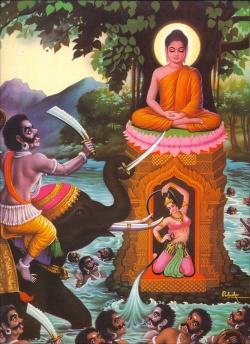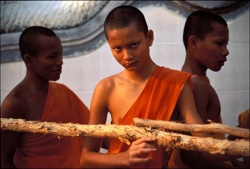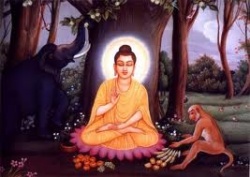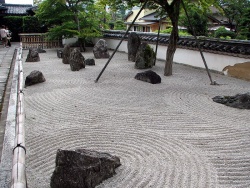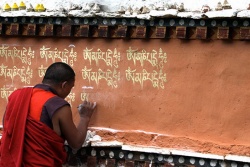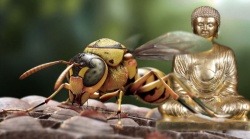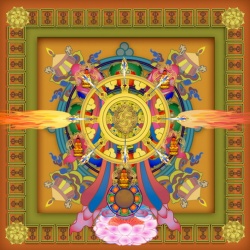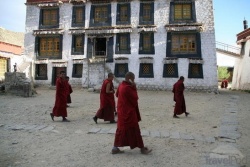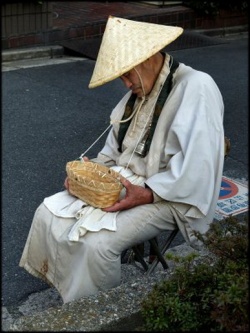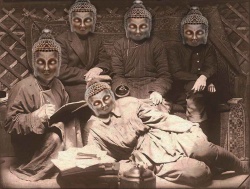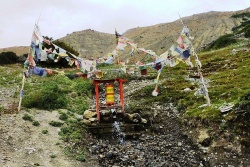Mara
In theistic religions the Devil, sometimes also known as Satan or Beelzebub, is a being completely opposed to God and to goodness. According to the Tipitaka, the Buddha was approached on several occasions by a spirit named Mara who tried to stop him from continuing his struggles for enlightenment, to tempt him and to encourage him to die (Sutta Nipata 426; Digha Nikaya 2. 103). Many Buddhists believe that Mara is an actual being while others contend that it is really an allegory or a personification of negative states of mind. There would seem to be more evidence for this second opinion than for the first. This is apparent from the fact that the Pali word màra means ‘death’ or ‘bringing death’ and that Mara’s three offspring are named Lobha, Dosa and Moha, meaning Greed, Hatred and Delusion. This interpretation is further supported by the fact that Buddhism sees evil as thoughts, speech and action motivated by ignorance rather than the machinations of a force external to the human mind. Mara is sometimes also called Kaõha, the Dark One (Majjhima Nikaya 1. 377), or Namuci (Digha Nikaya 2. 259).
Source
Mara (Skt. Māra; Tib. བདུད་, Dü; Wyl. bdud) — mythologically said be a powerful god who dwells in Tushita, some distance from the city where the main gods dwell. Although he is a god from the form realm, because of his attachment to objects of desire, he dwells in one of the six heavens of the desire realm. He is also the master of illusion who attempted to prevent the Buddha from attaining enlightenment at Bodhgaya.
Alternative Translations
- Malevolent/Beguiling Forces (Dorje & Coleman)
See Also
Further Reading
In Tibetan
- Patrul Rinpoche, བདུད་ཀྱི་རྒྱུ་བརྟགས་ཏེ་སྤོང་ཚུལ་གྱི་མན་ངག་བདུད་ལས་རྣམ་རྒྱལ་, bdud kyi rgyu brtags te spong tshul gyi man ngag bdud las rnam rgyal (Vol. III of The Collected Works of Patrul Rinpoche, published by སི་ཁྲོན་མི་རིགས་དཔར་སྐྲུན་ཁང་, si khron mi rigs dpar skrun khang in 2003, pages 305-337).
Source
Mara (Sanskrit, also Māra; Tibetan Wylie: bdud; Burmese: မာရ်နတ်; Thai: มาร), in Buddhism, is the demon that tempted Gautama Buddha by trying to seduce him with the vision of beautiful women who, in various legends, are often said to be Mara's daughters. In Buddhist cosmology, Mara personifies unwholesome impulses, unskillfulness, the "death" of the spiritual life. He is a tempter, distracting humans from practicing the spiritual life by making the mundane alluring or the negative seem positive.
The early Buddhists, however, rather than seeing Mara as a demonic, virtually all-powerful Lord of Evil, regarded him as more of a nuisance. Many episodes concerning his interactions with the Buddha have a decidedly humorous air to them.
Etymology
The word "Mara" comes from the Proto-Indo-European root *mer meaning to die, and so it is related to the European Mara, the Slavic Marzanna and the Latvian Māra. Mara in Latvian mythology means — The Mother of Earth and has positive meaning. She is wise and generous.
In traditional Hinduism Mara meaning "He who wounds" is one of the several names for the Vedic God of love and desire Kamadeva.
Overview
In traditional Buddhism four senses of the word "mara" are given.
- Klesa-mara, or Mara as the embodiment of all unskillful emotions.
- Mrtyu-mara, or Mara as death, in the sense of the ceaseless round of birth and death.
- Skandha-mara, or Mara as metaphor for the entirety of conditioned existence.
- Devaputra-mara, or Mara the son of a deva (god), that is, Mara as an objectively existent being rather than as a metaphor.
Overseer
Early Buddhism acknowledged both a literal and "psychological" interpretation of Mara. Mara is described both as an entity having a literal existence, just as the various deities of the Vedic pantheon are shown existing around the Buddha, and also is described as a primarily psychological force — a metaphor for various processes of doubt and temptation that obstruct spiritual practice.
Mara is described both as an entity having a existence in Kāmadhātu, just as are shown existing around the Buddha, and also is described in paṭiccasamuppāda as a primarily the guardian of passion a catalyst for lust, hesitation and fear that obstruct Meditation among Buddhists .
"Buddha defying Mara" is a common pose of Buddha sculptures. The Buddha is shown with his left hand in his lap, palm facing upwards and his right hand on his right knee. The fingers of his right hand touch the earth, to call the earth as his witness for defying Mara and achieving enlightenment. This posture is also referred to as the earth-touching mudra.
Three daughters
In some accounts of the Buddha's enlightenment, it is said that the demon Māra sent his three daughters to tempt the Buddha to give up his quest. Mara's three daughters are identified as Taṇhā (Craving), Arati (Boredom), and Raga (Passion). For example, in the Samyutta Nikaya's Māra-saṃyutta, Mara's three daughters fail to entice the Buddha:
- They had come to him glittering with beauty —
- Taṇhā, Arati, and Rāga —
- But the Teacher swept them away right there
- As the wind, a fallen cotton tuft.
Some stories refer to the existence of Five Daughters, who represent the Three Poisons, Attraction, Aversion and Delusion, accompanied additionally by Pride and Fear.
Skandha-maras
Maras as manifestations of the five skandhas are described in the Śūraṅgama Sūtra. In its section on the fifty skandha-maras, each of the five skandhas has ten skandha-maras associated with it, and each skandha-mara is described in detail as a deviation from correct samādhi. These skandha-maras are also known as the "fifty skandha demons" in some English-language publications.
Source
Literally: "murder, destruction", the Devil of the Sixth Heaven. Although the embodiment of death, Mara symbolizes in Buddhism the passions that overwhelm human beings as well as everything that hinders the development of wholesome roots and progress on the path of enlightenment."
Literally: "death. The tempter". The personification of evil in Buddhist mythology."
Source
Mara is a Hindu goddess of death.
In Hinduism, Mara brings death (Mrtyu) in the same way that Kama brings love and intimacy. On their own, neither is important, but act more as attributes than as deities. Generally references to Mara as an individual are referenced to Maya Devi (Queen Māyā).
Source
Wikipedia:Mara (Hindu goddess)
The personification of evil and temptation.
Literally, "murderer". The Evil One who "takes" away the wisdom life of all living beings.
Death, "the Striker" or "Tempter" or "The Evil One" or "The Killer"; embodiment of the selfish attachments and temptations that bind one to the cycle of birth and death. The opposite of the Buddha nature in each person.
Mara is Sanskrit for a demon, and refers to anything that obstructs the attainment of liberation or enlightenment. There are four principal types of mara: the mara of the delusions, the mara of contaminated aggregates, the mara of uncontrolled death, and the Devaputra maras. Of these, only the last are actual sentient beings. The principal Devaputra mara is wrathful Ishvara, the highest of the desire realm gods, who inhabits Land of Controlling Emanations. A Buddha is called a `ConqueroraE because he or she has conquered all four types of mara. See Heart of Wisdom.
sin; the opposite of Right Action
Generally regarded as the personification of Death, the Evil One, the Tempter (the Buddhist counterpart of the Devil or Principle of Destruction). The legends concerning Mara are, in the books, very involved and defy any attempts at unravelling them. In the latest accounts, mention is made of five Maras Khandha Mara, Kilesa Mara, Abhisankhara Mara, Maccu Mara and Devaputta Mara
as shown in the following quotations: pancannam pi Maranam vijayato jino (ThagA.ii.16); sabbamittehi khandha kilesa bhisankharamaccudeva puttasankhate, sabbapaccatthike (ThagA.ii.46); sankhepato va pancakilesa khandhabhi sankhara devaputta maccumare abhanji, tasma . . . bhagava ti vuccati (Vsm.211).
Elsewhere, however, Mara is spoken of as one, three, or four. Where Mara is one, the reference is generally either to the kilesas or to Death. Thus: Marenati kilesamarena (ItvA.197); Marassa visaye ti kilesamarassa visaye (ThagA.ii.70); jetvana maccuno senam vimokkhena anavaran ti lokattayabhibyapanato diyaddhasahassadi vibhagato ca vipulatta annehi avaritum patisedhetum asakkuneyyatta ca maccuno, Marassa, senam vimokkhena ariyamaggena jetva (ItvA.198); Marasena ti ettha satte anatthe niyojento maretiti Maro (UdA.325); nihato Maro bodhimule ti vihato samucchinno kilesamaro bodhirukkhamule (Netti Cty. 235); vasam Marassa gacchatiti kilesamarassa ca sattamarassa (?) ca vasam gacchi (Netti, p. 86); tato sukhmnataram Marabandhanan ti kilesabandhanam pan etam tato sukhumataram (SA.iii.82); Maro maro ti maranam pucchati, maradhammo ti maranadhammo (SA.ii.246).
It is evidently with this same significance that the term Mara, in the older books, is applied to the whole of the worldly existence, the five khandhas, or the realm of rebirth, as opposed to Nibbana. Thus Mara is defined at CNid. (No. 506) as kammabhisankharavasena patisandhiko kandhamaro dhatumaro, ayatanamaro. And again: Maro Maro ti bhante vuccati katamo nu kho bhante Maro ti? Rupam kho, Radha, Maro, vedanamaro, sannamaro, sankharamaro vinnanam Maro (S.iii.195); yo kho Radha Maro tatra chando pahatabbo. Ko ca Radha Maro? Rupam kho Radha Maro . . . pe . . . vedanamaro. Tatra kho Radha chando pahatabbo (S.iii.198); sa upadiyamano kho bhikku baddho Marassa, anupadiyamano mutto papimato (S.iii.74); evam sukhumam kho bhikkhave, Vepacittibandhanam; tato sukhumataram marabandhanam; mannamano kho bhikkhave baddho Marassa, amannamano mutto papimato (S.iv.202); labhati Maro otaram, labhati Maro arammanam (S.iv.85); santi bhikkhave cakkhuvinneyyarupa ... pe . . . tan ce bhikkhu abhinandati . . . pe . . . ayam vuccati bhikkhave bhikkhu avasagato Marassa, Marassa vasam, gato (S.iv.91); dhunatha maccuno senam nalagaram va kunjaro ti pannindriyassa padathanam (Netti, p. 40);
(lit. 'the killer'), is the Buddhist 'Tempter-figure. He is often called 'Māra the Evil One' (pāpimā māro) or Namuci (lit. 'the non-liberator', i.e. the opponent of liberation). He appears in the texts both as a real person (i.e. as a deity) and as personification of evil and passions, of the totality of worldly existence, and of death. Later Pāli literature often speaks of a 'fivefold Māra' (pañca-māra): 1. M. as a deity (devaputta-māra), 2. the M. of defilements (kilesa-m.), 3. the M. of the aggregates (khandha-m.), 4. the M. of the karma-formations (kamma-m.), and 5. Māra as death (maccu-m.).
As a real person, M. is regarded as the deity ruling over the highest heaven of the sensuous sphere (kāmāvacara), that of the paranimmitavasavatti-devas, the 'deities wielding power over the creations of others' (Com. to M. 1). According to tradition, when the Bodhisatta was seated under the Bodhi-tree, Māra tried in vain to obstruct his attainment of Enlightenment, first by frightening him through his hosts of demons, etc., and then by his 3 daughters' allurements. This episode is called 'Māra's war' (māra-yuddha). For 7 years M. had followed the Buddha, looking for any weakness in him; that is, 6 years before the Enlightenment and one year after it (Sn. v. 446). He also tried to induce the Buddha to pass away into Parinibbāna without proclaiming the Dhamma, and also when the time for the Buddha's Parinibbāna had come, he urged him on. But the Buddha acted on his own insight in both cases. See D. 16.
For (3) M. as the aggregates, s. S. XXIII, 1, 11, 12, 23. See Padhāna Sutta (Sn. v. 425ff.); Māra Samyutta (S. IV).
A deva associated with death and hindrances to enlightenment. It was Mara who tempted Buddha under the bodhi tree.
the evil one;
Māra Skt., Pali, lit., “murder, destruction”; although actually the embodiment of death, Māra symbolizes in Buddhism the passions that overwhelm human beings as well as everything that hinders the arising of the wholesome roots and progress on the path of enlightenment.
Māra is the lord of the sixth heaven of the desire realm and is often depicted with a hundred arms, riding on an elephant.
